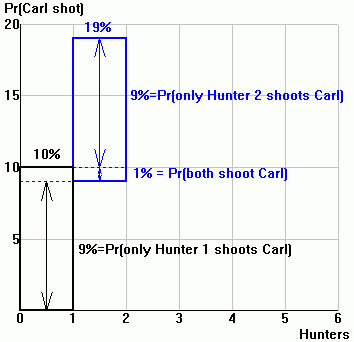| Situation as described by Friedman: 2 potential hunters pose a risk to hunter Carl: |
|
| (1) | Each has a 10% probability of fatally shooting Carl. |
| (2) | The value of Carl = $1 million |
| The question: To promote efficiency, how much should each hunter be liable for if both independently shoot Carl? | |
| (1) Friedman
says: $0: Since the second bullet causes no further harm,
the MCbullet2 = 0 Notice from the diagram that this remedy means that, if there is one hunter, that hunter faces a 10% risk of liability, but if there are two hunters, each hunter faces only a 9% risk of liability. Friedman asserts that assessing no liability in this situation is efficient since the additional hunter who fires the second bullet increased Carl's total risk of harm by only 9% which matches the 9% risk of liability built into this rule. |
|
